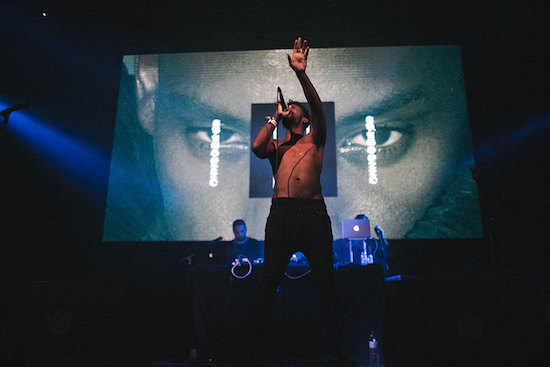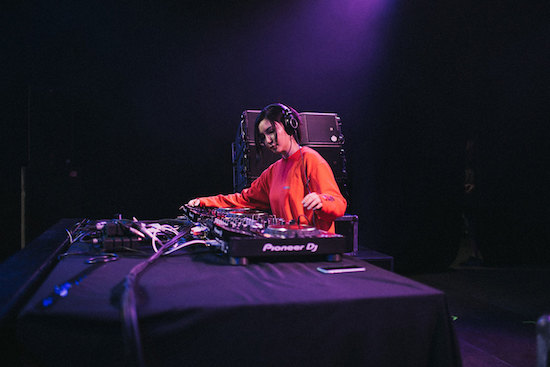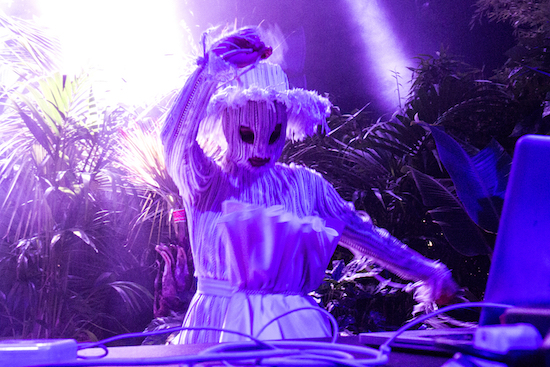Photos: Santiago Felipe, Vicky Grout, Fernando Schlaepfer
It is a wonderful wonderful thing to see an artist like Bad Gyal share a bill with someone like Arca. These juxtapositions, of musicians who are wildly different and whose careers are moving in wildly different directions, are part of the genetic makeup of Sónar. They are part of what makes it a singularly joyous experience, more than two decades after the festival began. And joy, as it goes, is an essential element of Sónar: where electronic music in 2017 (for all its sonic diversity, this is an electronic-focused festival) is often criticised for a kind of isolationist, quasi-academic and stony-faced inaccessibility, Sónar always prizes the euphoric group experience without detriment to the individual.
And so tQ is back all too briefly in Barcelona, a city tranquillised but very much alive after hosting Primavera only the week before, a little tired around the eyes but still potently coming up, faced with the prospect of another week without sleep. Sónar 2017 begins with an appearance from Björk, and while it’s true that Iceland’s most famous dóttir has been flown in to DJ rather than perform her own music, she still pulls out all the theatrical stops. The stage is converted into a forest for the evening, switching between verdant serenity and a violently purpling electric bruise, with Björk building from the ground up, a slow-burn explosion of life. It’s a near-perfect way to start the festival, and it’s emblematic of Sónar as a whole: full of contradictions and idiosyncrasies, the first of many sets which remind us that, beyond the festival’s desire to entertain, there’s a desire to challenge its audience and its artists, providing a chance to party for 72 hours, but also a nudge to reassess, to reconnect. To think about what we’ve learned…

GAIKA is currently Brixton’s greatest sonic export
GAIKA fills one of the festival’s biggest venues not with extra volume or added theatricality but by making genuine emotional connections with the crowd. We are only days after the Grenfell Tower disaster at this point – pictures and sounds are imprinted on the mind’s eye of anyone attending the festival from the UK, we are tender and angry. What is already perhaps GAIKA’s most potent vocal refrain – “This is our city and these are our streets in a state of emergency” from the SPAGHETTO EP’s exceptionally powerful ‘3D’ – is even more powerful at Sónar this weekend, not only for the context but also for its pre-existence, for a crowd perhaps realising for the first time that this horrible sense of injustice they feel is not a transient revelation but a permanent state for so many people.
Requests for young people to join in a united Europe, commands to hug the person next to you, to devote physical and mental energy to a sense of shared loss and shared belonging – these are things that could easily be met with cynicism and an eyeroll. Here they are not only acknowledged but embraced, with an understanding that whether this is about something lost or something gained, it is nonetheless something shared.
Science isn’t dead (at least not in Barcelona)
While most festivals warm consumers gently into the day with low-level indie bands and novelty acts, Sónar kicks off its first full day of music with actual proper science, courtesy of Entropy, a collaboration between astronomer and cosmologist Dr Dida Markovic, digital arts label Antivj, coder Elie Zananiri, Detroit techno legends Dopplereffekt and thousands of scientists who contributed their research.
The idea, essentially, is to tell the story of the universe, from the Big Bang to the universe’s possible demise, using floating visualisations of real astronomical data, Dopplereffekt’s chilling Detroit ambience (played live) and a lecture from Dr Markovic that is pitched perfectly – it is understandable and comprehensive.
Most people will have some idea of extremes of scale, temperature and time that the history of the Big Bang theory entails – a mixture of astronomically small moments in time and billion-year histories, played out at extreme densities and heats – but Entropy does a fantastic job of reminding us just how mindblowingly extreme the birth of the universe was and stands as a tribute to the human thirst for scientific knowledge and advancement, something that is more relevant than ever in the era of Trump and Michael Gove’s knuckle-dragging disdain for experts.
That makes the show sound decidedly dry, though, which Entropy is emphatically not. It is immersive and fascinating, like being sucked into a particular entertaining science programme in your dreams, while Dopplereffekt’s soundtrack is wonder of cosmic machine funk.

Spain’s got the R&B and trap bug…
Historically, Spain has been a country where rap and R&B haven’t made much of a mark compared to, say, their French neighbours. But the past five or so years have seen this change, with a new generation of young Spanish acts emerging that use R&B, hip hop and in particular trap to their own means.
Sónar 2017 showcases a number of these acts on its new SonarXS stage, a space dedicated to “the new derivations of dancehall, juke, rap and trap in Spain”, most notably Catalan trap queen Bad Gyal, whose brand of “sad dancehall” has become ubiquitous this summer. She draws a massive crowd on Friday for a gig that feels like something of a coronation, the crowd wailing along enthusiastically to local (for the time being) hits like ‘Mercadona’ and ‘Pai’ and, if her music may not be massively original, it has enough pop nous and swagger behind it to suggest that Bad Gyal may translate international interest into actual success.
The same, sadly, can’t be said for Yung Beef on the back of his Sónar gig. If Bad Gyal is the queen of Spanish trap, then Yung Beef is the emperor, a founder member of Barcelona rap collective PXXR GVNG, who have done more than any one to advance the Spanish trap sound. Beef’s Sónar show should be something of a victory lap but it is marred by muddied, weakling sound which makes Beef’s lyrics all but unintelligible and deadens the rib-rattling impact of his beats.
BFlecha, a young producer and singer from Oviedo, fits tangentially into this mix. Her productions mix R&B and rave sounds into a fantastically exciting sonic stew, which sounds majestic on the Sonar Village’s pounding sound system under Thursday afternoon’s baking sun, but her voice gets a bit lost among the epic electronics and it doesn’t feel like she has the melodies to match the fantastic production, yet.
…but trap’s role as music’s lingua franca is getting tiresome
Of course, Spain is far from the only country where trap has made an impact, and if Sónar 2017 proves anything it is that the slippery wasp hi-hats and drum machine thump of trap have become today’s pop music lingua franca, with trap beats present in everything from Sturla Atlas’s awkward Icelandic hip hop to Stööki Sound’s party playlists to Gaika’s dark dancehall.
There’s something refreshing about the way in which young producers and DJs from around the world have taken the none-more-American sound of trap and used it to their own twisted ends, rather than being cowed by the US’s cultural dominance. And yet after three days at Sónar, being chased around by the same hi hat and bass drum bounce, you do wonder how long it is before the preponderance of landfill trap will chase the sound back underground.

Thundercat could learn a thing from Nadia Rose about brevity
In an unfortunate quirk of festival programming, Thundercat takes to the SonarDome for his live set while the excitement of Nadia Rose’s Sonar Village show still lies rampant in the blood.
It’s not that the two artists are particular similar: Thundercat’s sunshine bass funk is a world away from Rose’s swaggering Croydon grime hop. But Rose’s Sónar show overflows with the two qualities that Thundercat’s set notably lacks: brevity and energy. The fast-rising MC’s set may only last 35 minutes – of which she is on the stage for maybe 25 – but into this brief time she manages to cram as much incandescent verve and pop panache as we have seen all day.
Thundercat, by contrast, makes his 70-minute set sludge by at the pace of continental drift, packing at least two bass solos into every song, often before we’ve got to the first chorus, to the wearying displeasure of the crowd who drift away like their own disintegrating Pangaea. Maybe this would work well at his own gig, where we can sit back and relax into Thundercat’s world. But at a festival, where there’s digital art to see and wristbands to top up with drinks cash, it feels like a misstep, which is hugely frustrating given the brilliant songs at Thundercat’s disposal.
Floorplan prove that simplicity can be effective
There is a lot of very clever electronic music at Sónar 2017, from Matmos’ washing machine-based experiments to Arca’s avant-pop. Floorplan’s Friday evening set, however, was not among these intellectual offerings. It was dumber than a bag of rocks and all the better for it.
What Floorplan do is simple in its essence, marrying soul, funk and disco loops to thundering drum machines. But they do it so incredibly well – calling on Robert Hood’s 20-plus years of experience in building minimal bangers plus his daughter Lyric’s youthful exuberance – that their live set is a joy to behold, running the gambit of some of the duo’s best-known songs, including the scorched-earth intensity of ‘Baby, Baby’ and an ecstatic ‘Tell You No Lie’. It is a set that proves, once again, that while combining a loop with a machine beat might not be rocket science, folding precisely the right sample into the mix at exactly the right time is a skill equal to anything that pushes the sonic envelope (and probably even more fun).

MIIIN’s “xeno dark music” shows that electronic music can still shock
For pampered journalists who have been around the musical block, it can be tempting to conclude that we have seen and done it all in electronic music, with the prospect of revolving 80s and 90s revivals all that awaits us in the glimmering future.
This is nonsense, of course, but it is always refreshing to be reassured of that, particularly when it comes in as vital a creative form as Korean producer MIIIN and her globetrotting “xeno dark music”. It probably helped that I knew nothing about MIIIN when I stumbled across her Thursday afternoon set, more in the search of shade than mind-altering beats. Her fascinating, tough and subtle mixture of house beats, cartoon pop and global dance resonated like Junior Vasquez with a sugar headache.
Fantastically, she closed her set by upping the weirdness quota, throwing distorted drum and bass, a tribal techno take on Goldie’s ‘Inner City Life’, apocalyptic gabber and Rihanna’s ‘Diamonds’ into her final ten minutes, leaving a delighted, sweaty and moshed-out crowd to emerge blinking and exhausted into the Catalan sun.


